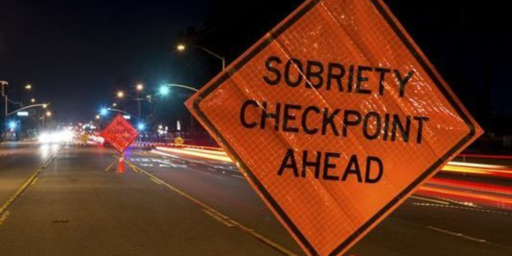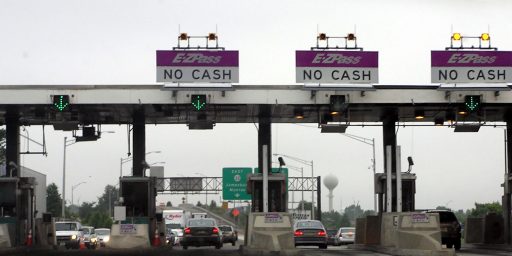Is Driving Faster, Safer?
Yesterday’s OpinionJournal notes something we don’t hear everyday: “Driving on the highways is safer today than ever before.”
In 2005, according to new data from the National Highway Safety Administration, the rate of injuries per mile traveled was lower than at any time since the Interstate Highway System was built 50 years ago. The fatality rate was the second lowest ever, just a tick higher than in 2004.
Both during the Bush administration, I’d point out. If post hoc ergo propter hoc works for the other side, it should work for us, too.
As a public policy matter, this steady decline is a vindication of the repeal of the 55 miles per hour federal speed limit law in 1995. That 1974 federal speed limit was arguably the most disobeyed and despised law since Prohibition. “Double nickel,” as it was often called, was first adopted to save gasoline during the Arab oil embargo, though later the justification became saving lives. But to Westerners with open spaces and low traffic density, the law became a symbol of the heavy hand of the federal nanny state. To top it off, Congress would deny states their own federal highway construction dollars if they failed to comply.
In repealing the law, the newly minted Republican majority in Congress declared that states were free to impose their own limits. Many states immediately took up this nod to federalism by raising their limits to 70 or 75 mph. Texas just raised its speed limit again on rural highways to 80.
This may seem non-controversial now, but at the time the debate was shrill and filled with predictions of doom. Ralph Nader claimed that “history will never forgive Congress for this assault on the sanctity of human life.” Judith Stone, president of the Advocates for Highway and Auto Safety, predicted to Katie Couric on NBC’s “Today Show” that there would be “6,400 added highway fatalities a year and millions of more injuries.” Federico Pena, the Clinton Administration’s Secretary of Transportation, declared: “Allowing speed limits to rise above 55 simply means that more Americans will die and be injured on our highways.”
We now have 10 years of evidence proving that the only “assault” was on the sanctity of the truth. The nearby table shows that the death, injury and crash rates have fallen sharply since 1995. Per mile traveled, there were about 5,000 fewer deaths and almost one million fewer injuries in 2005 than in the mid-1990s. This is all the more remarkable given that a dozen years ago Americans lacked today’s distraction of driving while also talking on their cell phones.
Indeed. Of course, bivariate analysis tends not to be particularly useful. More of us are driving larger vehicles than in 1995, most states require people to wear seatbelts, cars are equipped ith air bags, and so forth.
Of the 31 states that have raised their speed limits to more than 70 mph, 29 saw a decline in the death and injury rate and only two–the Dakotas–have seen fatalities increase. Two studies, by the National Motorists Association and by the Cato Institute, have compared crash data in states that raised their speed limits with those that didn’t and found no increase in deaths in the higher speed states.
This, however, would seem to help alleviate the defects just described. Now, there may be differences in SUV ownership rates and so forth in fast vice slow states that explain this. Still, it’s quite interesting that a comparison of contemporary data shows no difference in fatality rates. One would think these states would have roughly equivalent rates of SUV ownership, cell phone use, seat belt wearing, and the like. Indeed, if anything, one would think “faster” states are predominately rural and thus poorer and more likely to be driving older, less safety featured, cars and less likely to be wearing seat belts.
Jim Baxter, president of the National Motorists Association, says that by the early 1990s “compliance with the 55 mph law was only about 5%–in other words, about 95% of drivers were exceeding the speed limit.” Now motorists can coast at these faster speeds without being on the constant lookout for radar guns, speed traps and state troopers. Americans have also arrived at their destinations sooner, worth an estimated $30 billion a year in time saved, according to the Cato study.
Or, it could be that people are pretty much driving as fast as they safely can everywhere and the posted speed limit is simply irrelevant. In my experience, people on the highway don’t drive the speed limit or the speed limit plus 5 or 10 mph; they drive around 75 mph regardless. My guess is that people in Texas are driving 80-85 mph in the 80 mph limit zones and 80-85 mph in the 65 mph zones.






For the most part, speed limits have absolutely nothing whatsoever to do with safety, and everything to do with making money, by way of fines.
Any patrol officer will tell you: the biggest speed problems are the handful of nitwits going way faster than everyone else and the handful of nitwits going way slower than everyone else. Most people have a well-defined comfort zone, and they stay within it, and they don’t cause any problems.
The speed limits are enforced in Texas, but there is usually a 5 to 10 MPH buffer. Not always, but usually. This means people tend to keep to the speed limit + buffer.
In town, we have several stretches that are 60mph. You can tell the out of staters because they just don’t seem to believe that you can do 60 in the city. Of course there is also one FM road that goes from 60 to 45 as it gets closer to connecting to a 60mph road. That’s a popular speed trap area.
Bottom line is that whether the higher speed limits moves the traffic along as a unit better (so you don’t have one guy doing 55 and another 80), better safety features, bigger vehicles or whatever, we have another example of the left being as wrong as they could be about something affecting every day life and not a peep of apologizing or mentioning it.
There is also a state law limiting the percentage of funds any town, county, etc can make from traffic fines. It hasn’t eliminated, but has cut back on the traffic fine farming speed trap towns.
Oh, let’s leave out
1. Seatbelt use
2. Safer automobiles
3. Reduction in DUI
Sure, we are just driving so fast that we cannot have an accident any more